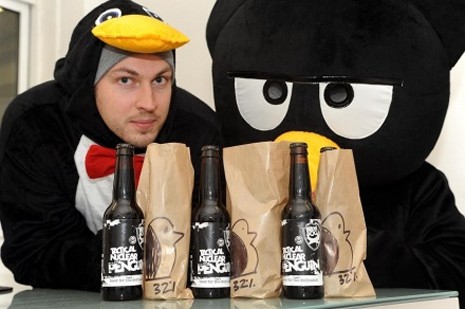Really High Alcohol Beer Gets You Really High
 Consumerist’s Chris Morran asks, “Are You Ready For Beer With 32% Alcohol Content?”
Consumerist’s Chris Morran asks, “Are You Ready For Beer With 32% Alcohol Content?”
Well, it’s a wee bit early in the day. But, philosophically speaking, I am!
He points us to “Super-High-Alcohol Beer Heads to the U.S.,” the sort of helpful article that, if Time published them more often, it wouldn’t be in danger of going out of business. I mean, talk about News You Can Use.
Thanks to a war among European brewing companies, it’s never been easier to catch a healthy beer buzz. Or get yourself totally sloshed. In November, BrewDog, a three-year-old Scottish microbrewery, released a new brand, dubbed Tactical Nuclear Penguin. The beer set a new record by weighing in at a scary 32% alcohol by volume (ABV), more than six times the strength of familiar domestic brands like Budweiser. As explained in a cheeky video on the company’s website (warning: the clip contains simulated penguin sex), the brewery was able to attain the high alcohol content by freezing the beer at a local ice cream factory, at temperatures as low as -6°C (21°F), for 21 days. Alcohol freezes at lower temperatures than water, and removing water from the solution increased the alcohol concentration.
Jim Watt, one of BrewDog’s co-founders, says that some 400 bottles of Tactical Nuclear Penguin are in the process of being shipped to a few stores in California and New York City, including a Whole Foods location; about half of the consumers buying beer from the BrewDog website are from the U.S. Watt’s eyes are clearly fixed on the American market. “We’re keen to push the envelope,” he says, “and challenge people’s perceptions of how beer can be enjoyed.”
A warning label on the Tactical Nuclear Penguin bottle does state, “This is an extremely strong beer; it should be enjoyed in small servings and with an air of aristocratic nonchalance. It is exactly the same manner you would enjoy a fine whisky, a Frank Zappa album or a visit from a friendly yet anxious ghost.”
[…]
The drinking games continued in February when a German brewer, Schorschbrau, released a 40% ABV beer called Schorschbock. The BrewDog boys fired back a few weeks later with high-octane concoction Sink the Bismarck!, which checks in at 41%, enough to reclaim the “world’s strongest beer” mantle (the name is a not-so-subtle reference to the famous German battleship deployed during World War II).
Shockingly, some mewling watchdog groups think this is “irresponsible” and are trying to get this banned. And, while perhaps they have a point when they note that most people don’t check the labels for alcohol content. But, once again, the Invisible Hand steps in:
For now, Sink the Bismarck! is only available for purchase on BrewDog’s website, and the 500 or so bottles that BrewDog has produced are already sold out. Watt promises that more are on the way. Because of the painstaking process involved with producing such a strong drink, an 11.2-oz. bottle of Sink the Bismarck! costs some $60, minus shipping. Tactical Nuclear Penguin costs about $53 a bottle, and can also be ordered online.
Even if these brands end up being carried by more bars and retailers, Watt firmly believes that the high prices will prohibit unsophisticated drinkers (read: high school kids at a kegger, or college students on spring break) from just picking up the stuff and chugging it.
Considering that you can buy a bottle of Johnny Walker Black for that — hell, you can get some single malts for that — my guess is that these beers will be scarfed up by wealthy connoisseurs for the novelty. But, even were this to develop into a more affordable, mass market concept, most people aren’t going to be interested in drinking beer so strong that they’re unable to finish the bottle before it gets warm.

Technically is this stuff still beer? Yes, it’s brewed but so is sake. Once it’s frozen I would think most or all the carbonation would disappear and you would be left with a flat, strong but unpleasant drink.
Finishing the bottle before it gets warm would possibly kill you. (I hope it isn’t sold with a crown-cap.)
From the reviews at Beer Advocate, extreme amounts of hops are used to cover the alcohol taste. The hops will weaken with age.
Mr. Prosser, they probably prime the bottles with a sugar to carbonate the final product, or they could artificially pump in carbonation during the bottling stage. As long as the ingredients are standard (malted barley, wheat, yeast, hops) I would still think of it as beer. But while I like the idea of a super strong brew, I am not a fan of very hoppy beers.
I saw this article a few weeks ago and thought “Why the kerfuffle now?”
Samuel Adams has had a beer with 27% ABV for sale now for quite a while. It’s called Utopia and I hear its quite good.
Unrelated, Kerfuffle is a word that deserves stronger use in our modern lexicon.